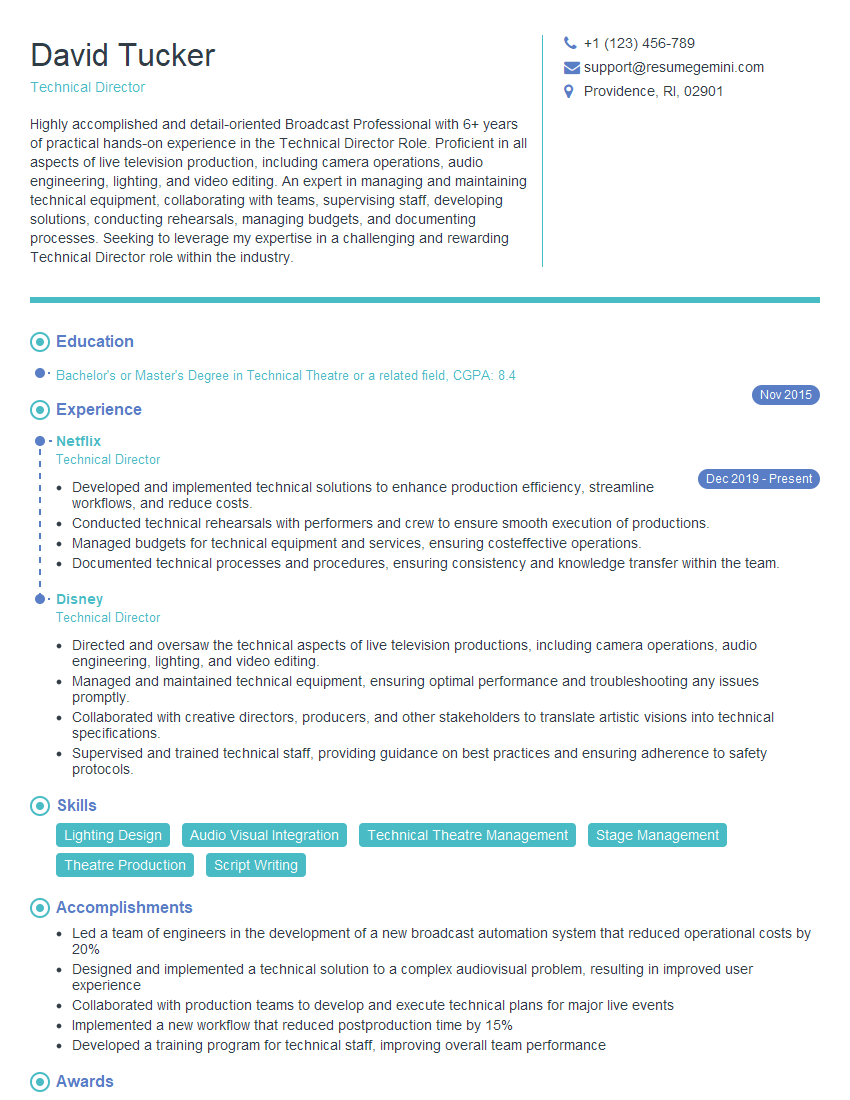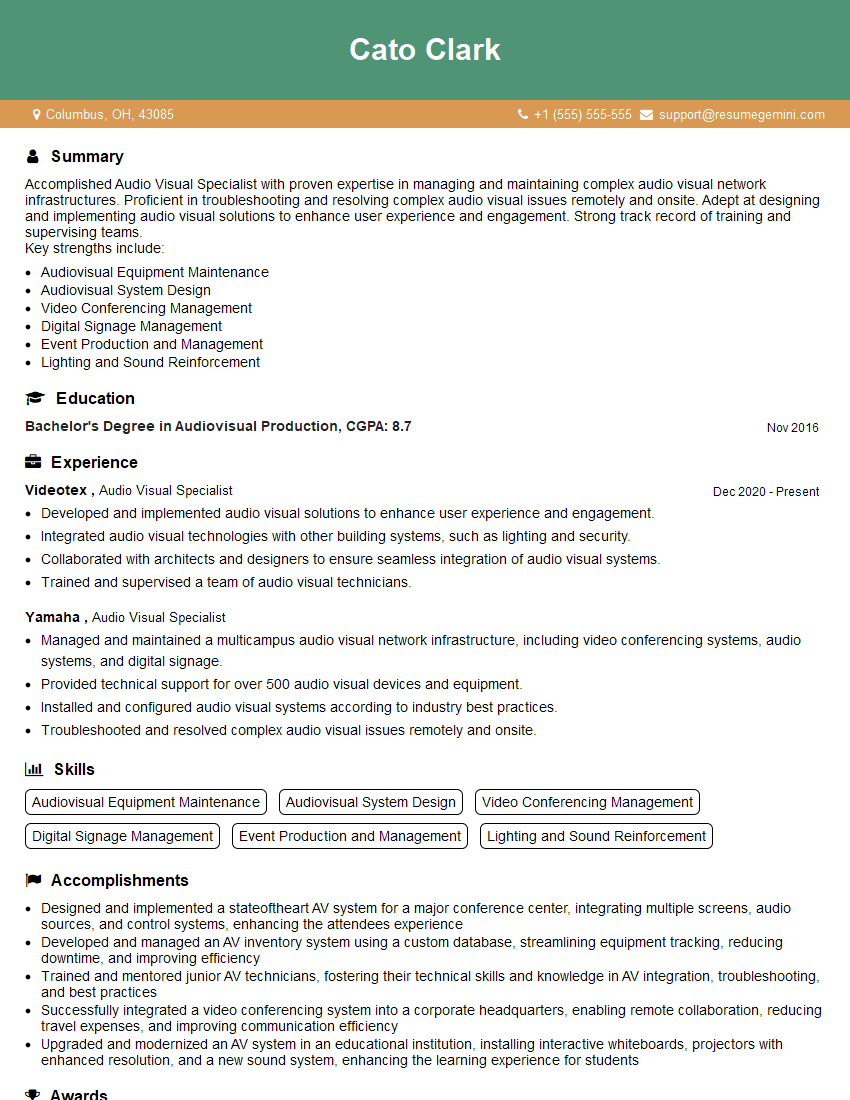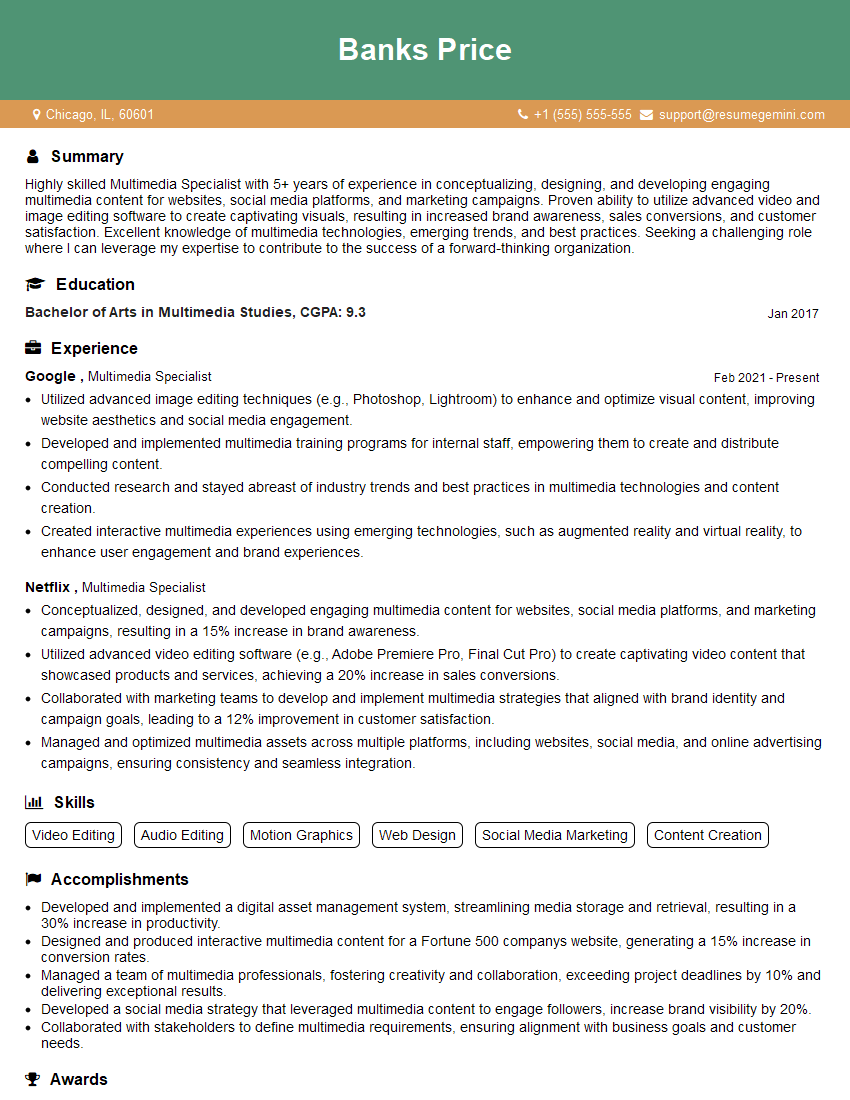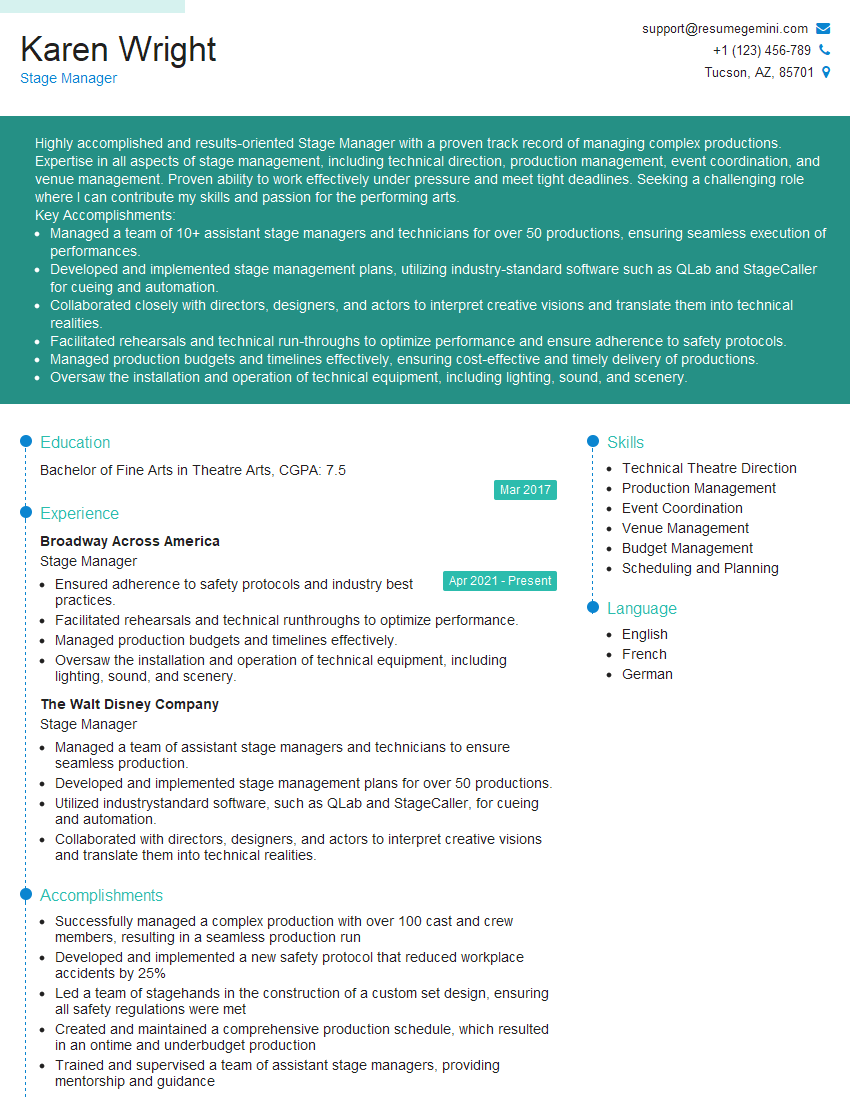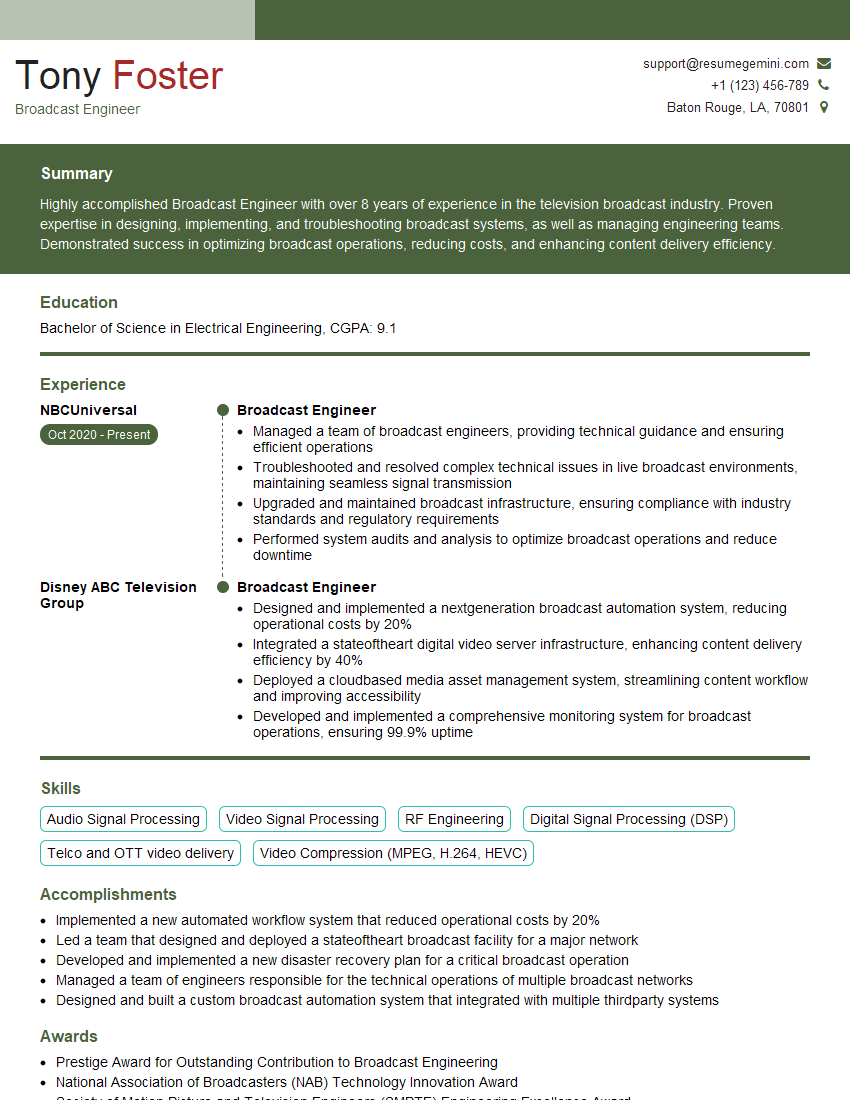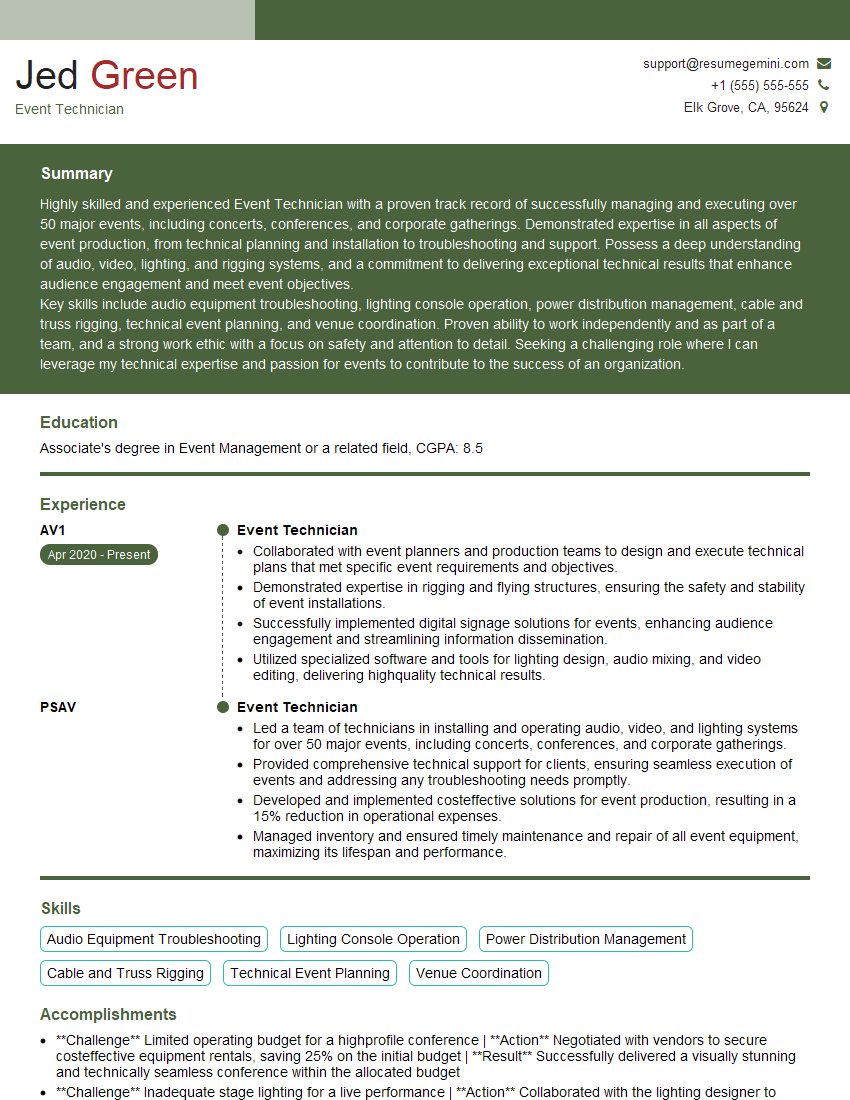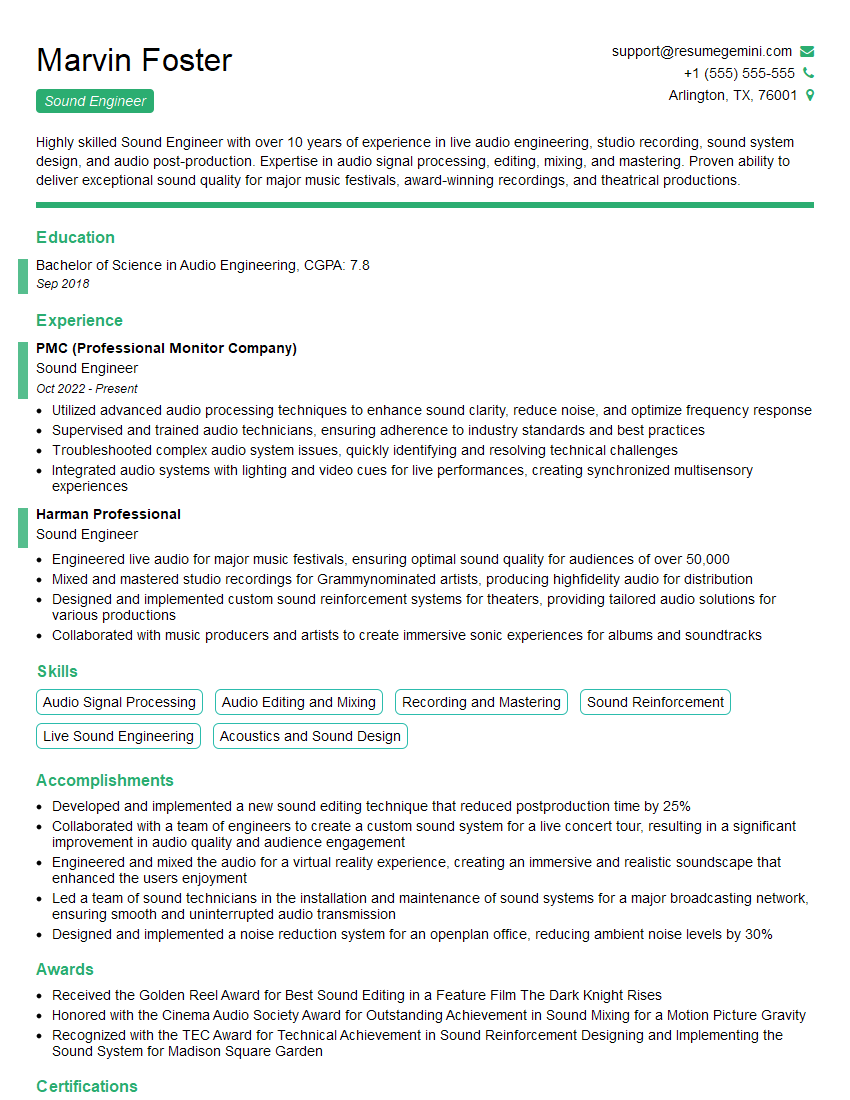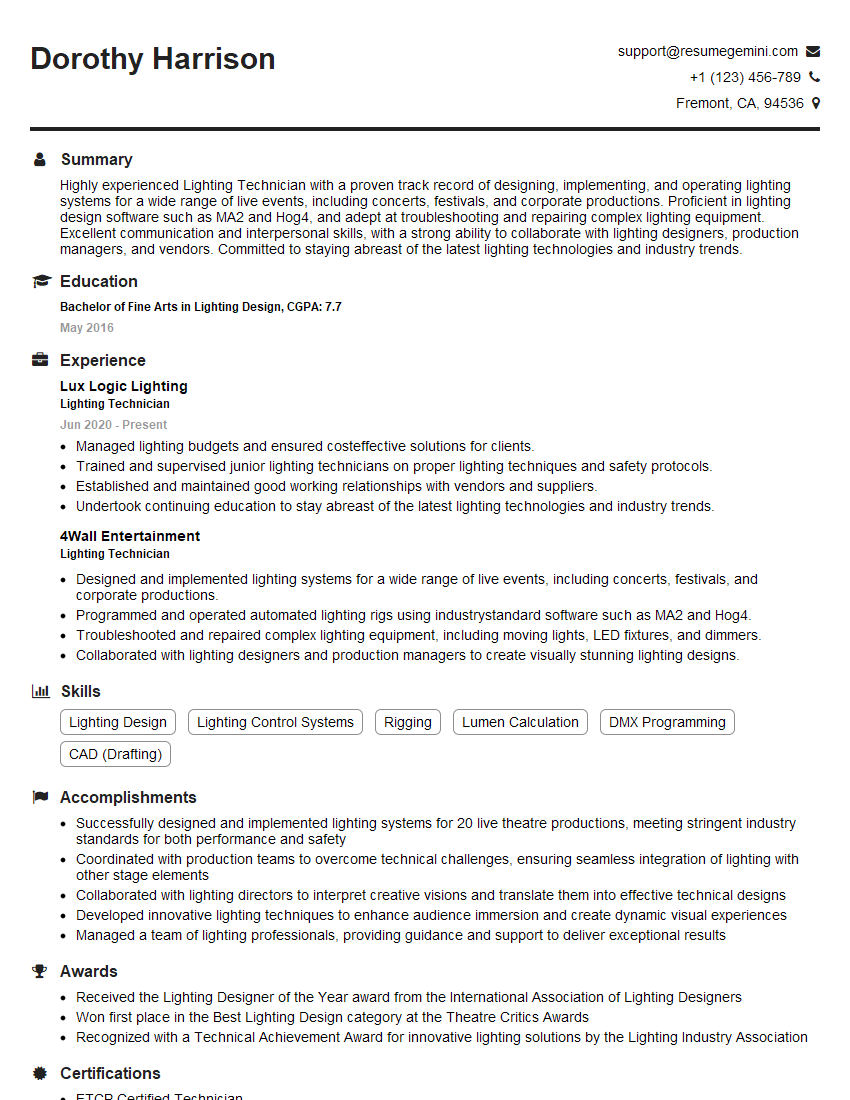Unlock your full potential by mastering the most common Experience with Lighting and Sound Design interview questions. This blog offers a deep dive into the critical topics, ensuring you’re not only prepared to answer but to excel. With these insights, you’ll approach your interview with clarity and confidence.
Questions Asked in Experience with Lighting and Sound Design Interview
Q 1. Explain the difference between incandescent, fluorescent, and LED lighting.
The three lighting technologies – incandescent, fluorescent, and LED – differ fundamentally in how they produce light, impacting their efficiency, lifespan, and color rendering.
- Incandescent: These bulbs generate light by heating a filament until it glows. They are inefficient, producing a lot of heat as a byproduct, and have a relatively short lifespan. Their light is warm and inviting, but lacks color accuracy.
- Fluorescent: These bulbs use electricity to excite mercury vapor, producing ultraviolet (UV) light. This UV light then strikes a phosphor coating on the inside of the bulb, converting it into visible light. Fluorescent bulbs are more energy-efficient than incandescent but contain mercury, posing disposal challenges. Their light is generally cooler and can sometimes appear less natural.
- LED (Light Emitting Diode): LEDs are semiconductor devices that emit light when an electric current passes through them. They are highly energy-efficient, long-lasting, and available in a wide range of color temperatures and color rendering indices (CRI). A high CRI indicates better color accuracy, making them ideal for applications where color fidelity is crucial, like theatrical lighting.
In a theatrical setting, for instance, incandescent lights might be used for a warm, nostalgic ambiance, while LEDs offer the versatility needed for precise color mixing and dynamic effects.
Q 2. Describe your experience with different types of microphones and their applications.
My experience spans a wide range of microphones, each suited to specific applications. The choice depends heavily on the sound source, environment, and desired sound quality.
- Dynamic Microphones: These are robust, durable, and handle high sound pressure levels well. They are excellent for live performances, particularly loud instruments like drums and amplified guitars. The Shure SM57 is a classic example, renowned for its ability to capture crisp, detailed sound from snare drums.
- Condenser Microphones: These are more sensitive than dynamic mics and capture a wider frequency range, resulting in a more detailed and nuanced sound. They are preferred for recording vocals, acoustic instruments, and ambient sounds. Large-diaphragm condenser microphones, like the Neumann U 87, are frequently used in recording studios for their warm and clear sound.
- Boundary Microphones: These are designed to be mounted on surfaces, ideal for conferencing or capturing sound from a table. They offer a convenient and unobtrusive way to pick up sound.
- Wireless Microphones: These offer freedom of movement for performers. However, they require careful frequency management to avoid interference.
For a recent musical theater production, we used a combination of dynamic microphones for close miking instruments and condenser microphones for capturing the subtle nuances of the vocalists. The choice of microphone is crucial for achieving the desired sonic character of the performance.
Q 3. How do you troubleshoot a faulty sound system during a live performance?
Troubleshooting a faulty sound system during a live performance requires a systematic approach. The key is to identify the problem quickly and efficiently to minimize disruption.
- Identify the symptom: Is there no sound at all, distortion, feedback, or a loss of specific channels?
- Isolate the problem: Check the obvious – are the cables connected properly? Is the power on? Are the volume levels appropriately set?
- Check individual components: If the issue is with a specific channel, examine the microphone, cable, and mixer input. Is there a signal at the mixer? If not, the problem lies before the mixer.
- Utilize backup equipment: If a microphone or other component fails, having backup equipment ready to swap in is crucial.
- Consider the environment: RF interference, ground loops, or issues with the PA system’s grounding can cause unexpected problems. Proper grounding and shielding are key.
- Communicate: Maintain clear communication with the performers and technical crew. Explaining the situation to the audience can mitigate any negative impact.
During a recent concert, a faulty cable caused a complete loss of sound from one vocalist’s microphone. By quickly identifying the problem and swapping out the cable, we minimized the disruption to the performance.
Q 4. What are the key considerations for designing lighting for a theatrical production?
Designing lighting for a theatrical production is a multifaceted process involving artistic vision, technical expertise, and careful consideration of the narrative.
- Plot and Story: Lighting should enhance the storytelling, creating mood, atmosphere, and highlighting key moments.
- Color and Temperature: Color is crucial for mood and character. Warm colors suggest intimacy while cool colors evoke distance or tension. Color temperature (measured in Kelvin) influences the overall feel, with lower temperatures producing warmer light.
- Intensity and Movement: The intensity of the lighting can control focus and highlight particular areas or actors. Movement, created with automated lighting fixtures, can add dynamism and visual interest.
- Visibility and Readability: The lighting must ensure sufficient visibility for the audience to see the actors and stage design effectively. Poor lighting can obscure details and diminish the impact of the production.
- Safety: Electrical safety is paramount. Proper cabling, grounding, and fixture placement are essential.
For example, a dark and shadowy scene might utilize low-intensity blue light to create a sense of mystery, whereas a joyful scene could be bathed in bright, warm yellow light.
Q 5. Explain your understanding of audio mixing consoles and their functionalities.
An audio mixing console is the central hub for managing and manipulating audio signals. It allows for the control of multiple audio sources, enabling adjustments to volume, equalization (EQ), panning, and effects processing.
Functionalities include:
- Input Channels: Each channel typically allows for the connection of a microphone or line-level signal. This is where you control the initial gain staging, EQ, and other signal processing for each input.
- Auxiliary Sends: These sends route signals to effects processors (like reverb or delay) or monitor mixes.
- EQ (Equalization): Adjusts the balance of different frequencies within a signal to shape its tonal character.
- Dynamics Processing: Tools such as compressors and gates manage signal levels to control dynamics and prevent clipping.
- Output Channels: These route the mixed signals to amplifiers or recording devices.
- Master Bus: The final output mix is controlled at the master bus, where the overall level and final EQ adjustments are made.
A digital mixing console offers additional flexibility through automation and recall of settings, making it ideal for large-scale productions. Understanding the intricate functionalities of a mixing console is essential for achieving a well-balanced and professional-sounding mix.
Q 6. Describe your experience with lighting control systems (e.g., ETC EOS, MA Lighting).
I have extensive experience with both ETC EOS and MA Lighting control systems, two of the industry-leading platforms for lighting control.
ETC EOS: Known for its intuitive interface and powerful features. I’ve used it on numerous productions, appreciating its flexibility in handling complex cue lists, intricate lighting designs, and network integration. Its programming language allows for efficient setup and automation.
MA Lighting: MA systems, particularly the grandMA2, are renowned for their advanced capabilities, particularly in large-scale shows. Its powerful processing capabilities allow for handling very complex lighting cues. The network functionality enables control across many fixtures from multiple consoles.
The choice between these systems often depends on the scale and complexity of the production. For smaller productions, the ETC EOS might suffice, while large-scale events may demand the robust features of an MA system. Proficiency in both gives me versatility for various projects. I find that both systems rely heavily on a deep understanding of lighting design principles and the ability to use the systems effectively to implement those principles.
Q 7. How do you achieve good acoustic balance in a room?
Achieving good acoustic balance in a room involves minimizing undesirable reflections, reverberation, and noise, while optimizing the clarity and intelligibility of sound. This is crucial for creating a pleasing and effective listening environment.
- Room Shape and Size: The shape and size of the room significantly impact acoustics. Irregular shapes help diffuse sound, reducing reflections. However, excessive absorption or reflection needs to be addressed based on usage.
- Absorption: Absorptive materials (such as acoustic panels, carpets, and curtains) are used to reduce reverberation and control echo. The placement and amount of absorption are vital for a balanced sound.
- Diffusion: Diffusers scatter sound waves, preventing echoes and creating a more natural and even sound field. These are particularly useful in controlling problematic reflections.
- Isolation: To minimize noise from outside the room, soundproofing techniques should be implemented, including sound-resistant walls, doors, and windows.
- Treatment Strategy: A successful acoustic treatment approach involves combining absorption and diffusion to create a suitable reverberation time, depending on the intended use of the room. A reverberation time that’s too long leads to muddiness, while one that is too short creates a dry, lifeless sound. This should be addressed based on professional testing and tuning.
For instance, a recording studio needs to be heavily treated to minimize reflections and ensure pristine sound quality. In contrast, a concert hall may require different strategies to achieve a more vibrant and spacious sound.
Q 8. What software are you proficient in for lighting and/or sound design?
My proficiency spans several industry-standard software packages for both lighting and sound design. For lighting, I’m highly skilled in Vectorworks Spotlight, known for its powerful 3D modeling and visualization capabilities, allowing me to create detailed lighting plots and simulations before a single fixture is even hung. I also have extensive experience with WYSIWYG, which provides a crucial real-time rendering environment for precise fixture placement and lighting effect preview. For sound, Q-Lab is my go-to for complex audio playback and show control, ensuring seamless transitions and precise timing. I’m also adept at using Dante Controller for managing networked audio systems, a critical skill for larger-scale productions. Finally, I’m comfortable with SoundDesigner Pro for audio editing and post-production work.
Q 9. Describe your process for designing a sound system for a specific venue.
Designing a sound system begins with a thorough site survey. I assess the venue’s acoustics, considering factors like size, shape, ceiling height, and the presence of reflective surfaces. This informs the choice of speaker type and placement. For instance, a large, reverberant space might require more speakers with tighter dispersion patterns, potentially including line array systems. Conversely, a smaller, intimate space may only need a few strategically positioned full-range speakers. Next, I analyze the intended use. A concert will have very different requirements from a corporate event. This dictates the level of sound reinforcement needed and what type of microphone systems are required. Then comes system design using software like EASE Focus to model sound coverage and predict potential problem areas. Finally, I create a detailed specification document for procurement and installation, ensuring system components are correctly integrated and appropriately powered. For example, in a recent theatre renovation, detailed acoustic modelling helped to identify areas with excessive reverberation, which we addressed by incorporating strategic sound absorption panels, resulting in a much cleaner and clearer sound system.
Q 10. How do you handle feedback in a sound system?
Feedback, that high-pitched squeal, is a common audio problem caused by a microphone picking up its own amplified sound. My approach to handling feedback involves several steps. First, I always prioritize microphone placement – carefully positioning them away from loudspeakers. Second, I use proper microphone techniques like proper gain staging and equalization. Gain staging is about setting appropriate levels throughout the system, while equalization (EQ) is used to shape the sound. For instance, a notch filter can be used to target a specific frequency that is causing the feedback. Third, I employ feedback suppression devices such as feedback reducers or limiters. These processors analyze sound and automatically reduce gain in feedback-prone frequencies. Fourth, and perhaps most importantly, I use a combination of room treatment and careful speaker placement to improve the acoustic environment, minimizing the risk of feedback from the start. Often, it’s not about just fixing the feedback, but rather creating a better acoustical environment which naturally reduces issues.
Q 11. Explain the concept of color temperature in lighting design.
Color temperature in lighting design refers to the perceived warmth or coolness of a light source, measured in Kelvin (K). Lower Kelvin values indicate warmer colors – think of the warm, yellowish glow of a candle (around 1800K). Higher Kelvin values correspond to cooler colors, like the bluish light of a clear winter sky (around 10,000K). This concept is crucial for setting the mood and atmosphere of a space. For instance, warm light creates a cozy and inviting environment, suitable for restaurants or residential spaces. Cooler light, on the other hand, might be used in offices or galleries to enhance focus and clarity. Consider a theatrical production: using warmer tones in romantic scenes, then shifting to cooler hues during tense moments creates a powerful visual narrative. Understanding color temperature allows me to create a visual palette tailored to the specific mood of the performance.
Q 12. What are your strategies for managing sound levels during a live event?
Managing sound levels during a live event requires careful planning and execution. Pre-event sound checks are crucial to ensure the system’s output is appropriately balanced and doesn’t exceed safe listening levels. We typically use sound level meters to measure decibel levels at various points in the venue. During the event, I use a mixing console with dynamic limiters and compressors to control the overall volume, preventing peaks from exceeding pre-determined thresholds, and maintaining consistent levels. Clear communication with the performers and the audience is vital. I educate performers about using microphones correctly and setting appropriate monitoring levels. Audience feedback can also help fine-tune the overall sound experience. In addition, distributing audio information to the audience via multiple smaller speakers helps achieve better control over the sound levels throughout the venue and reduces feedback problems. Often, a visual cue is given to the audience to ensure they understand and adhere to the sound level limits.
Q 13. How do you incorporate safety measures into your lighting and sound designs?
Safety is paramount in lighting and sound design. For lighting, I rigorously follow all relevant safety regulations and ensure all equipment is properly grounded and tested before use. We utilize safety chains and proper rigging techniques to secure all lighting fixtures, preventing accidental falls. Regular maintenance checks of equipment are crucial. For sound, I ensure all equipment is properly connected and wired, preventing short circuits and electrical hazards. Proper ear protection is mandatory for everyone working with sound equipment, minimizing risk of hearing damage. I also ensure that the sound system’s output level is controlled to avoid acoustic overexposure to both the performers and the audience. Moreover, I always have appropriate emergency procedures in place and thoroughly educate all personnel on emergency shutdown procedures.
Q 14. Explain your experience with different types of speakers and their applications.
My experience encompasses a wide range of speakers, each with its specific application. Full-range speakers are versatile and used for general-purpose sound reinforcement, suitable for smaller venues. Subwoofers handle low-frequency sounds, enhancing bass response in larger systems. Line array speakers are ideal for large venues, providing even sound coverage over long distances. Point-source speakers, offering good directional control, are used for smaller spaces or applications requiring precise sound projection. Monitor speakers provide sound for performers on stage, allowing them to hear themselves and the rest of the band. The choice of speaker depends largely on the venue’s size, acoustics, and the type of event. For example, in a stadium concert, line arrays would be vital for reaching large audiences, while in a small conference room, full-range speakers with careful placement would suffice. Understanding the acoustic properties of each type allows me to create the best listening environment possible.
Q 15. How familiar are you with audio signal flow and processing?
My understanding of audio signal flow and processing is comprehensive. It begins with the source – a microphone, instrument, or playback device – which produces an analog or digital signal. This signal then travels through various components. Think of it like a river flowing; the signal is the water, and each component is a feature of the river’s journey.
- Pre-Amplification: The signal is boosted to a usable level, often shaping its tone in the process (think of widening a river channel).
- Equalization (EQ): Frequencies are adjusted to balance the sound or enhance specific aspects. This might involve reducing muddiness in the low frequencies or boosting the clarity in the highs (like creating rapids or calming the waters).
- Compression: Dynamic range (the difference between loud and quiet sounds) is controlled to make the signal more consistent, preventing clipping and adding punch (like managing the river’s flow during a flood).
- Effects Processing: Reverb, delay, chorus, and other effects are added to create atmosphere and texture (like adding bends and waterfalls to the river).
- Mixing: Multiple audio signals are combined to create a cohesive sound (like merging several rivers into a larger one).
- Amplification: The mixed signal is amplified to a suitable level for playback (like a hydroelectric dam harnessing the river’s power).
I’m proficient in using digital audio workstations (DAWs) such as Pro Tools and Ableton Live, and familiar with various hardware processors. I can troubleshoot signal flow issues efficiently, identifying problems in cabling, equipment malfunction, or software settings.
Career Expert Tips:
- Ace those interviews! Prepare effectively by reviewing the Top 50 Most Common Interview Questions on ResumeGemini.
- Navigate your job search with confidence! Explore a wide range of Career Tips on ResumeGemini. Learn about common challenges and recommendations to overcome them.
- Craft the perfect resume! Master the Art of Resume Writing with ResumeGemini’s guide. Showcase your unique qualifications and achievements effectively.
- Don’t miss out on holiday savings! Build your dream resume with ResumeGemini’s ATS optimized templates.
Q 16. Describe your approach to creating a mood or atmosphere through lighting.
Creating mood through lighting is about manipulating color, intensity, and direction to evoke specific emotions. I approach this by first understanding the story or intended atmosphere. Is it a romantic comedy, a tense thriller, or a peaceful drama? Each demands a different palette.
For example, warm, saturated colors like amber and deep reds can create intimacy and romance. Conversely, cool blues and greens can evoke a sense of calm or loneliness. Harsh, direct lighting can suggest aggression or tension, while soft, diffused light might indicate serenity or mystery.
My process involves:
- Concept Development: Closely collaborating with the director, I translate the scene’s emotional intent into a lighting design.
- Color Palette Selection: Choosing colors that accurately reflect the mood and resonate with the audience.
- Lighting Placement and Intensity: Strategically placing fixtures to highlight key areas and create depth and shadow. This includes using gobos (templates projected onto a surface) for unique effects.
- Dynamic Lighting: Incorporating changes in intensity and color over time to enhance the narrative, building tension or releasing it.
I have experience using a range of lighting techniques, from subtle ambient lighting to dramatic spotlights, always adapting my approach to the specific needs of the production.
Q 17. How do you work with other members of a production team?
Collaboration is paramount in live performance and media production. I thrive in team environments, working closely with directors, cinematographers, sound engineers, and other technicians. Clear communication and proactive problem-solving are essential.
My approach emphasizes:
- Open Communication: I actively listen to the input of others, respecting their expertise and sharing my own knowledge freely.
- Pre-Production Meetings: I attend and participate actively, providing input on lighting and sound design, ensuring compatibility and addressing potential conflicts.
- Technical Coordination: I coordinate closely with the technical director to ensure the seamless integration of lighting and sound with other elements of the production.
- Problem-Solving: I take a proactive approach to identifying and addressing technical challenges, collaborating with the team to find effective solutions.
For instance, on a recent theatre production, I worked closely with the set designer to ensure my lighting design complemented the set’s architecture, enhancing the overall visual experience.
Q 18. What are your experience with different types of light fixtures (e.g., PAR cans, Fresnels)?
My experience with various light fixtures is extensive. I am comfortable working with a wide range, from basic instruments to highly specialized units. Each type offers unique characteristics suitable for specific applications.
- PAR Cans (Parabolic Aluminized Reflectors): Excellent for wash lighting, providing a wide, even spread of light. I often use them for backlighting or creating ambient washes.
- Fresnels: Versatile instruments with adjustable beam angles, ideal for focused lighting, spot effects, or creating dramatic highlights. Their ability to soften or sharpen the beam edge is crucial for creating nuanced lighting schemes.
- LED Fixtures: I extensively use these for their energy efficiency, color mixing capabilities, and long lifespan. The versatility offered by various color temperatures and adjustable intensity makes them incredibly useful.
- Moving Lights: These offer dynamic effects, allowing for precise control over beam shape, color, and movement. They are essential for high-impact shows or concerts.
I understand the color temperature properties of each fixture and their impact on the overall lighting design. I can calculate light levels and adjust accordingly to ensure even coverage or create dramatic contrast.
Q 19. Explain your understanding of sound equalization and compression.
Sound equalization and compression are crucial tools for shaping and controlling audio. They are used to adjust the balance and dynamic range of audio signals.
- Equalization (EQ): EQ allows you to boost or cut specific frequencies. Imagine a graphic equalizer as a series of sliders controlling different frequencies; boosting highs makes the sound brighter, cutting lows removes muddiness. EQ is used to correct imbalances, enhance certain instruments, and shape the overall tonal character of a mix. For instance, you might boost the presence frequencies of a vocal to make it cut through a mix.
- Compression: Compression reduces the dynamic range of a signal – the difference between the loudest and quietest parts. A compressor reduces the volume of loud signals and boosts quieter ones, resulting in a more consistent and even level. This is crucial for controlling dynamics, preventing distortion, and making audio signals louder. For example, you might compress a drum track to make it punchier and more consistent in volume.
Both EQ and compression require a skillful ear and understanding of audio frequencies and dynamics. Incorrect use can lead to an unnatural or thin sound. I’m highly proficient in utilizing both for optimal results.
Q 20. How do you create a balanced mix for both live and recorded audio?
Creating a balanced mix, whether live or recorded, requires a holistic approach involving careful attention to detail and a good understanding of audio principles. The goal is to ensure that each instrument and vocal is audible, clear, and sits well within the overall soundscape without any element overpowering another.
My process involves:
- Gain Staging: Setting appropriate input levels to prevent clipping and maximize signal-to-noise ratio. This is a foundational step for any successful mix.
- EQ and Compression: Careful application of EQ and compression to individual tracks and the master bus. This enhances clarity, controls dynamics, and achieves a cohesive sound.
- Panning: Positioning instruments and vocals in the stereo field to create width and depth, preventing muddiness in the center.
- Effects Processing: Adding reverb, delay, and other effects judiciously, avoiding excessive use that muddies the mix.
- Monitoring: Listening critically on various playback systems to ensure balance and clarity across different environments.
For live sound, quick reflexes and problem-solving are critical. For recording, I leverage DAWs with extensive mixing capabilities to refine and perfect the final product. A well-balanced mix prioritizes clarity, creates interest, and leaves a lasting impression.
Q 21. How do you test and maintain audio-visual equipment?
Testing and maintaining audio-visual equipment is crucial for ensuring smooth productions. My approach is proactive and systematic, encompassing regular checks and preventative maintenance.
My process includes:
- Pre-Production Checks: Thorough testing of all equipment before the event, including cables, connections, and functionality of all devices.
- Functional Tests: Checking for signal integrity, proper output levels, and absence of noise or distortion.
- Calibration: Adjusting and calibrating equipment to ensure consistency and accuracy of audio and visual signals. This might involve microphone gain staging, speaker alignment, and display color calibration.
- Preventive Maintenance: Regular cleaning of equipment, checking for wear and tear, and promptly addressing any minor issues to prevent major problems.
- Troubleshooting: Effectively diagnosing and resolving any technical problems that arise, using my knowledge of the systems and their components.
For example, during a recent concert, I noticed a slight hum in the monitor system. Through systematic checking, I identified a faulty cable, replaced it, and averted a potential performance issue. Proactive maintenance and thorough testing are vital to my workflow.
Q 22. What are the common challenges you face in lighting and sound design and how do you address them?
Common challenges in lighting and sound design often revolve around budget constraints, time limitations, and the unpredictable nature of live events. For example, a tight budget might necessitate creative solutions using readily available equipment, perhaps prioritizing LED fixtures over more expensive moving lights. Time pressure is ever-present; a quick turnaround necessitates efficient pre-production planning and on-site problem-solving. Unpredictable variables, such as unexpected power outages or a last-minute change in the performer’s requirements, demand adaptability and quick thinking.
I address these by implementing meticulous pre-planning. This includes creating detailed budgets, timelines, and contingency plans. For instance, I’ll always have backup lighting units on hand and ensure that all equipment is thoroughly tested before the event. During the event itself, strong communication with the team is crucial. I maintain open channels of communication with the director, stage manager, and other technical personnel, allowing for quick responses to any unexpected issues. Flexibility is key; I’m prepared to adapt my designs on the fly if needed, always prioritizing the success of the event.
Q 23. Describe your experience with stage lighting rigging and safety procedures.
My experience with stage lighting rigging is extensive, encompassing both conventional and automated lighting systems. This includes working with various types of trussing, counterweights, motors, and safety lines. Rigging is inherently risky, so adherence to strict safety protocols is paramount. I’ve always ensured that every aspect of the rigging process, from initial design to final de-rigging, complies with all relevant safety regulations and best practices.
Before each event, we conduct thorough inspections of all rigging hardware. We use certified riggers and employ established safety checks, such as load testing and regular inspections of all equipment. Each crew member receives comprehensive training in safe rigging procedures, including proper weight calculations, knot-tying, and emergency protocols. We meticulously document all aspects of the rigging process, including weight distribution calculations, equipment specifications, and safety checks performed, creating a safety-first culture on all productions.
Q 24. How do you handle unexpected technical issues during a live event?
Handling unexpected technical issues during a live event requires a calm, methodical approach. My first step is to assess the situation quickly and accurately – what exactly has malfunctioned, and what’s the immediate impact on the show? Then, I prioritize solutions based on severity. A minor issue, like a blown bulb in a less prominent fixture, might be temporarily ignored in favor of addressing more critical problems.
For instance, if a crucial sound system component fails, I’ll immediately switch to a backup system, if available. If a lighting fixture fails during a critical moment, I might adjust the lighting design on the fly to compensate, utilizing other available fixtures. Effective communication is key, I’ll immediately inform the relevant personnel about the problem and the temporary workaround, keeping everyone in the loop to maintain a smooth show flow. After the event, I conduct a thorough post-mortem analysis to identify the root cause of the failure and implement preventative measures to avoid similar situations in the future. Thorough documentation and preventative maintenance significantly reduce the risk of such unexpected issues.
Q 25. What are your experience with different types of audio editing software?
My experience encompasses a wide range of audio editing software, including industry standards like Pro Tools, Logic Pro X, Ableton Live, and Audacity. Each software has its own strengths; Pro Tools excels in professional recording and mixing, while Logic Pro X provides an intuitive environment for composing and arranging music. Ableton Live is ideal for live performance and electronic music production, and Audacity offers a free, user-friendly option for basic audio editing tasks.
I’ve utilized these tools for various projects, from recording and mixing live performances to post-production sound design for film and theatre. My proficiency includes mastering various techniques such as noise reduction, equalization, compression, reverb, and delay, ensuring optimal audio quality. A recent project used Pro Tools to clean up audio recordings of a live orchestra for a documentary film, and Ableton Live to create bespoke sound effects for an immersive theatre production. The choice of software always depends on the specific requirements of the project; there is no ‘one-size-fits-all’ solution in this case.
Q 26. Explain your experience with creating and using light plots and sound plans.
Creating and using light plots and sound plans are essential parts of my design process. A light plot is a detailed visual representation of the lighting design, showing the position, type, and aiming of each fixture, including color and intensity information. Similarly, a sound plan maps out the audio system layout, microphone placement, speaker positions, and signal routing.
I use specialized software like Vectorworks or AutoCAD to create these plans, ensuring accuracy and clarity. These plans serve as crucial communication tools, providing a common understanding of the design for the entire technical crew. They also aid in pre-visualization and problem-solving, allowing me to identify potential issues early on. For instance, in a recent theatre production, the light plot helped me determine the optimum angles and positions for lighting instruments to achieve the desired effects while avoiding any obstructions on stage. The sound plan, on the other hand, allowed for careful placement of microphones and speakers to ensure optimum sound quality and minimize feedback.
Q 27. How do you approach designing for accessibility needs in a venue?
Designing for accessibility is crucial for creating inclusive and enjoyable experiences for all audience members. This includes considerations for people with visual, auditory, and mobility impairments. For visually impaired patrons, providing clear audio descriptions during performances and ensuring adequate tactile signage is essential. For those with auditory impairments, closed captioning and assistive listening devices should be incorporated into the design. For mobility-impaired individuals, ensuring accessible entrances, seating areas, and restrooms is vital.
I collaborate closely with venue management and accessibility specialists to understand the specific needs of the audience. This might involve strategically placing audio loops for the hearing impaired, providing alternative sensory experiences, or modifying lighting design to reduce potential triggers for those with light sensitivity. In a recent concert, we incorporated a visual representation of the music through lighting and projections to complement the audio experience for those with hearing impairments. This proactive approach ensures that everyone can fully engage with and appreciate the event.
Q 28. Describe your understanding of digital audio workstations (DAWs).
Digital Audio Workstations (DAWs) are the cornerstone of modern audio production. They are sophisticated software applications that provide a comprehensive platform for recording, editing, mixing, and mastering audio. Popular DAWs include Pro Tools, Logic Pro X, Ableton Live, Cubase, and Reaper. They combine a variety of tools, such as multitrack recording capabilities, virtual instruments, effects processors, and MIDI sequencing.
My understanding of DAWs extends beyond basic functionalities to a deeper knowledge of their capabilities in various contexts. I can effectively use them to record and edit multi-track audio, create and manipulate MIDI data, apply various audio effects, and mix and master tracks to professional standards. I’m proficient in utilizing various plugins to enhance the audio, from compression and equalization to reverb and delay. DAWs allow for a level of precision and control previously unimaginable, offering incredible versatility in sound creation and manipulation.
Key Topics to Learn for Experience with Lighting and Sound Design Interview
- Lighting Fundamentals: Understanding color temperature, light intensity, and different lighting instruments (e.g., Fresnels, PARs, LEDs). Practical application: Describing your experience with lighting plots and their execution in various settings.
- Sound Fundamentals: Knowledge of acoustics, microphone types, audio mixing consoles, and sound reinforcement systems. Practical application: Detailing your experience with sound system setup, troubleshooting audio issues, and mixing live performances.
- Software Proficiency: Familiarity with lighting and sound design software (e.g., Vectorworks, QLab, Reaper). Practical application: Demonstrating your proficiency in programming lighting cues, creating sound effects, and managing audio tracks.
- Technical Problem Solving: Ability to diagnose and solve technical issues related to lighting and sound equipment. Practical application: Sharing examples of overcoming challenges during productions, highlighting your problem-solving skills.
- Health and Safety: Understanding and adhering to safety regulations related to electrical equipment, rigging, and noise levels. Practical application: Demonstrating your commitment to safe working practices on past projects.
- Collaboration and Communication: Effective communication with directors, technicians, and other team members. Practical application: Describing your teamwork experiences and how you coordinated with other departments to achieve successful productions.
- Workflow and Project Management: Understanding the production workflow, from initial design to final execution. Practical application: Highlighting your experience in managing timelines, budgets, and resources on various projects.
Next Steps
Mastering lighting and sound design is crucial for career advancement in the creative industries, opening doors to exciting roles and collaborative opportunities. A strong resume is your key to unlocking these opportunities. Creating an ATS-friendly resume increases your chances of getting noticed by recruiters. ResumeGemini is a trusted resource to help you build a professional and impactful resume that highlights your skills and experience. Examples of resumes tailored to Experience with Lighting and Sound Design are available within ResumeGemini to help guide you in building your best possible application.
Explore more articles
Users Rating of Our Blogs
Share Your Experience
We value your feedback! Please rate our content and share your thoughts (optional).
What Readers Say About Our Blog
Hello,
We found issues with your domain’s email setup that may be sending your messages to spam or blocking them completely. InboxShield Mini shows you how to fix it in minutes — no tech skills required.
Scan your domain now for details: https://inboxshield-mini.com/
— Adam @ InboxShield Mini
Reply STOP to unsubscribe
Hi, are you owner of interviewgemini.com? What if I told you I could help you find extra time in your schedule, reconnect with leads you didn’t even realize you missed, and bring in more “I want to work with you” conversations, without increasing your ad spend or hiring a full-time employee?
All with a flexible, budget-friendly service that could easily pay for itself. Sounds good?
Would it be nice to jump on a quick 10-minute call so I can show you exactly how we make this work?
Best,
Hapei
Marketing Director
Hey, I know you’re the owner of interviewgemini.com. I’ll be quick.
Fundraising for your business is tough and time-consuming. We make it easier by guaranteeing two private investor meetings each month, for six months. No demos, no pitch events – just direct introductions to active investors matched to your startup.
If youR17;re raising, this could help you build real momentum. Want me to send more info?
Hi, I represent an SEO company that specialises in getting you AI citations and higher rankings on Google. I’d like to offer you a 100% free SEO audit for your website. Would you be interested?
Hi, I represent an SEO company that specialises in getting you AI citations and higher rankings on Google. I’d like to offer you a 100% free SEO audit for your website. Would you be interested?
good

